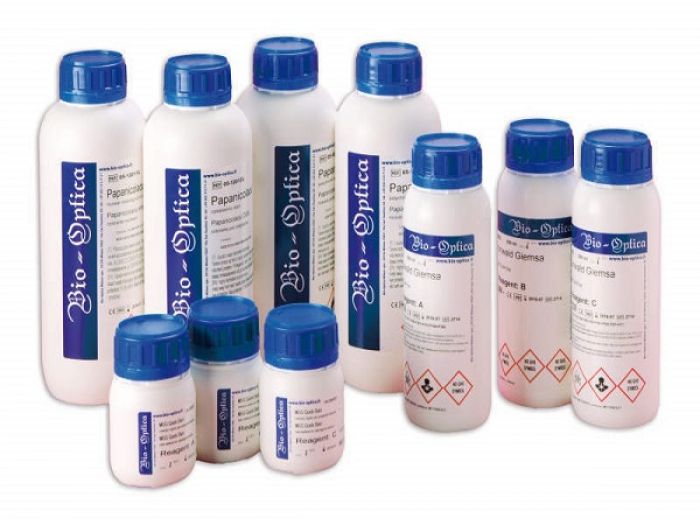




محلول رایت گیمسا (محلول آزور، ائوزین، بافر در متانول)
• برای رنگ آمیزی لام های خونی، نمونه های مغز استخوان، بیوپسی معده، برش های بافت پارافینی و ...
• بطری شیشه ای 250، 500 و 1000 میلی لیتری
• محلول آماده برای مصرف
• محلول آزور، ائوزین، بافر
• دارای الکل متانول
محلول رنگ آمیزی رایت گیمسا (محلول آزور، ائوزین، بافر در متانول)
از محلول رنگ رایت - گیمسا جهت رنگ آمیزی لام های خونی و نمونه های مغز استخوان و برش های بافت پارافینی می باشد.
نحوه استفاده از محلول رایت گیمسا
1- گستره را به وسیله متانول فیکس نمایید.
2- روی سطح لام یک میلی لیتر رنگ بریزید.
3- پس از 5 دقیقه یک میلی لیتر آب مقطر به سطح لام اضافه نمایید به طوری که آب مقطر و رنگ مخلوط شوند.
4- پس از گذشت 5 دقیقه لام را با آب بشویید و پس از خشک شدن زیر میکروسکوپ بررسی نمایید.
Wright-Giemsa Stain
Polychromatic Romanowsky dyes are a standard in hematology of blood smears and bone marrow. Various sorts of Romanowsky dyes (Giemsa, May-Gruenwald, Leishman, Wright, Jenner and others) contain different ratios of methylene blue used as the cation component (and the reagent-related thiazine dyes, such as azure B) and eosin Y as the anion component. Cation and anion components interaction creates a well-known Romanowsky effect that cannot be achieved if each component is being used individually. Purple color indicates the effect’s presence. Staining intensity depends on the azure B content, as well as azure B to eosin Y ratio, while a few other factors affect the result of staining: working solution pH value, fixation method and dye exposure time. Giemsa solution is used for differentiation of nuclear and/or cytoplasmatic morphology of lymphocytes, monocytes, granulocytes (neutrophils, eosinophils, basophils), thrombocytes and erythrocytes. There are various methods of using the Giemsa solution, and the so-called Pappenheim method is one of the most commonly used ones. The method is essentially the May-Gruenwald Giemsa method combined with the May-Gruenwald solution that stains cytological material (peripheral blood smears, cytodiagnostic puncture aspirates, diarrhea or secretion cells) or hematopoietic organs’ sections. Along with the Pappenheim method, the Giemsa solution is commonly used for chromosomatic aberrations detection in cytogenetics.
Romanowsky stain, for peripheral blood and bone marrow smears. Also used to perform differential white blood cell counts and to study red blood cell morphology. Abnormal granulocyte, lymphocyte or monocyte cell counts may be used to facilitate the diagnosis of diseases such as leukemia or bacterial infections.
Application
When blood films are stained using Wright-Giemsa Stain, the white blood cell nucleus and cytoplasm take on the characteristic blue or pink coloration. The combination of purified eosin and thiazine dyes in the product eliminates inconsistent staining and yields reproducible chromogenic responses.
